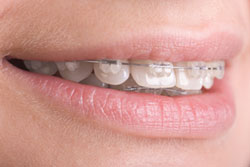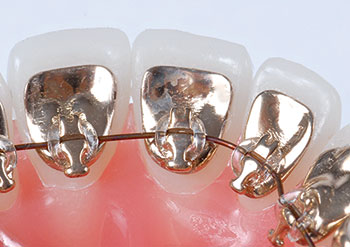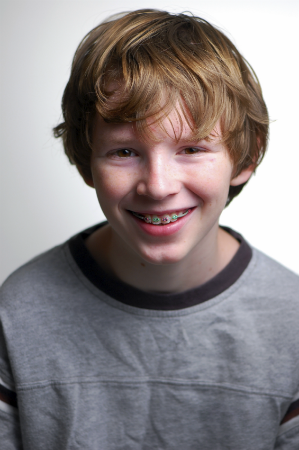Book an Appointment
(02) 93 000 999
Orthodontic treatment is used to treat dental and facial irregularities. You may need braces if:
You have over-crowded teeth
An underbite, over bite, cross bite or deep bite
Gaps between teeth
Misalignment of teeth (malocclusion) can lead to serious dental problems such as:
Higher risk of tooth decay
Gum disease
Headaches
Speaking, biting or chewing problems

Orthodontic treatment will not only help improve the health and function of your teeth, it can also boost your self-esteem with a new smile. You can benefit from orthodontic treatment at nearly any age, it’s never too late to start!
Want to straighten your teeth invisibly and gently? Think Invisalign!
The Invisalign system straightens your teeth by using a series of clear removable trays that are customised to your teeth. Since the aligners are virtually invisible, most people will not even notice you are wearing an Invisalign tray.
For more information about Invisalign at our practice, please visit Invisalign at Dentist Mandy Bondi.
When we think about braces, we usually think about traditional metal brackets bonded to the teeth and wires that move your teeth to the desired position. For traditional braces that use brackets and wires, your dentist will tighten the wires every 6 to 8 weeks, gradually moving your teeth or jaw into place.
Ceramic brackets or clear braces are clear or tooth-coloured brackets secured by wires that are far less visible than metal brackets. Ceramic brackets are often used on the upper front teeth and not on the lower teeth and molar teeth.


Lingual or concealed braces are brackets secured by wires that are attached behind your teeth, customised to match the shape of your teeth and are hidden from view.

Interceptive orthodontics is orthodontic treatment for young children that uses the growing jaw to guide permanent teeth to grow into the correct position to resolve any orthodontic issues that could arise in the future.
Early orthodontic treatment at an early age will give the dentist a chance to:
Guide jaw growth to create facial symmetry
Create room for crowded, erupting teeth
Reduce treatment time
Avoid the need for tooth extractions
At Dentist Mandy, we are committed to offering you solutions tailored to your individual needs.
Rest assured! Braces may cause slight discomfort but it can be easily managed with proper oral care. You may feel pressure from the wires and elastics as your teeth slowly align towards a lovely smile for you! Here are a few top tips to manage:
Eat softer foods such as yoghurt, soup and mashed potato.
Avoid hard foods that might damage your braces.
Avoid heavy staining foods such as curries, beetroot and gravies.
Apply orthodontic wax to keep braces from rubbing against the inside of your mouth.
Take ibuprofen or paracetamol to relieve mouth soreness and headaches from braces.
Rinse with salt water to relieve discomfort and swelling.
Everyone has a different set of teeth, so if someone wants to have braces, it will depend on where their teeth are and how they bite. It could take as short as 6 months or as long as a few years.
When you have braces on, it is important to brush and floss properly as there are more surfaces to trap plaque in. Here are steps to brush and floss teeth with braces on:
Using a 30-cm waxed floss, thread the floss behind the brace wire. Wrap the floss around your two index fingers until there is 5cm in between, and slowly lodge the floss between two teeth. Wrap the floss into a C-shape around each tooth and move the floss in a push-pull motion gently until all plaque is removed. Repeat this for the other side, and then floss all teeth.
Next, use an interdental brush to brush behind the wire and side of each bracket to remove plaque.
Using a soft or extra soft bristled toothbrush with toothpaste, place the bristles of the brush at a 45-degree angle along the gum line starting at the back teeth. Brush in circular motions and slowly sweep the toothbrush cleaning one to two teeth at a time for at least 10 circles. Next, place the toothbrush at a 45-degree angle above the brackets and sweep through the top of the bracket, and repeat this upside down for the bottom of the bracket. Repeat these steps for all surfaces of your teeth and brackets. Then gently brush your tongue to remove odour-causing bacteria.
Once you have braces on, it is recommended you see Dentist Mandy every 6 to 8 weeks. Braces or Invisalign work by moving your teeth into proper alignment and bite. Having periodic adjustments of archwires and elastic ligatures will allow your teeth to move properly.
A retainer is a device that holds your teeth in place to maintain the straightness of your teeth. There are two types of retainers: Fixed and removable.
A fixed retainer is a thin wire worn across the back of your lower or upper front teeth. A removable type of retainer is a device that is placed around your teeth to maintain the new alignment of your teeth. This device, however, can be removed at whenever you want, following the instructions given by Dentist Mandy
It is recommended that you wear your retainer every night or as often as possible to maintain the straightness of your teeth. It is also important to keep your removable retainers in a clean and dry place such as a retainer box, and brushing it with water to remove any debris.
